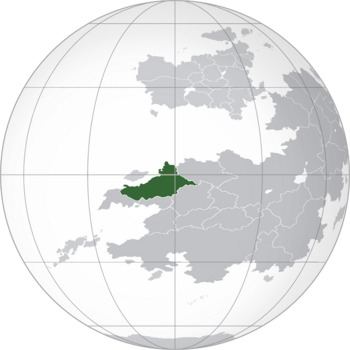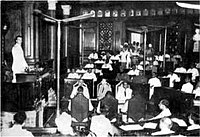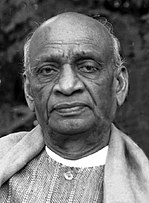User:Geordinia/sandbox2: Difference between revisions
No edit summary |
mNo edit summary |
||
| Line 127: | Line 127: | ||
The end of the [[Solarian War]] saw the end of Etrurian colonial rule over Satria Etruriana and the establishment of the newly independent Kingdom of Rajyaghar. At the time of independence, Satria was consumed by destruction following the [[Great War]] and subsequent Solarian War. Despite this, Rajyaghar had significant economic advantages. Rajyaghar was one of the largest producers of iron, and the industrial infrastructure built by [[Etruria]] was designed for efficient production, refinement and exportation of Rajyani natural resources. The resources also gave the Rajyani government the resources it would need to recover following the Solarian and Great Wars as well as invest in further industrial development and infrastructure. | The end of the [[Solarian War]] saw the end of Etrurian colonial rule over Satria Etruriana and the establishment of the newly independent Kingdom of Rajyaghar. At the time of independence, Satria was consumed by destruction following the [[Great War]] and subsequent Solarian War. Despite this, Rajyaghar had significant economic advantages. Rajyaghar was one of the largest producers of iron, and the industrial infrastructure built by [[Etruria]] was designed for efficient production, refinement and exportation of Rajyani natural resources. The resources also gave the Rajyani government the resources it would need to recover following the Solarian and Great Wars as well as invest in further industrial development and infrastructure. | ||
Independence itself resulted in increased tensions throughout the Kingdom with significant nationalist groups in | Independence itself resulted in increased tensions throughout the Kingdom with significant nationalist groups in Nivasasthan and Pinjar gaining prominence and councilst uprisings emerging in XX. It was also known that councilist organisations were funding councilist groups in XX and YY in an attempt to undermine the [[Central Union Government]]. | ||
Under the leadership of Premier [[Baiju Pahir Kapadia]] and his centrist People’s Party, the government placed a large emphasis on state planning with the military, education and investment receiving the largest amount of funding. These plans helped revive the economy following the wars of the early 20th Century and protect Rajyani sovereignty and integrity. However, the councilst uprisings in the Union State of XX continued to grow and in 19XX erupted into a total rebellion resulting in the XX Seccession. | Under the leadership of Premier [[Baiju Pahir Kapadia]] and his centrist People’s Party, the government placed a large emphasis on state planning with the military, education and investment receiving the largest amount of funding. These plans helped revive the economy following the wars of the early 20th Century and protect Rajyani sovereignty and integrity. However, the councilst uprisings in the Union State of XX continued to grow and in 19XX erupted into a total rebellion resulting in the XX Seccession. | ||
Revision as of 21:40, 22 April 2023
Kingdom of Rajyaghar રાજ્યઘર રાજ્ય | |
|---|---|
Motto: Rājā nī Jaya Hail to the King | |
 Location of Rajyaghar in Coius | |
| Capital and largest city | Kinadica |
| Official languages | Himavantan |
| Recognised regional languages | Matrabashi, Bhasdila, !Bihari, Tamisari |
| Ethnic groups (2021) |
|
| Religion | Ashankism (majority, unofficial) |
| Demonym(s) | Rajyani |
| Government | Federal, Parliamentary, Constitutional Monarchy |
• Maharaja | Krishan VII |
• Premier | Madhava Thakur |
| Legislature | Shahee Sansad |
| Council of States | |
| House of Representatives | |
| History of Rajyaghar | |
• Fall of the Rajana Dynasty | 815 CE |
• Creation of Satria Etruriana | 1847 CE |
• Independence from Etruria | 1946 CE |
| 19XX CE | |
• Saṅghīya Constitution | 19XX CE |
| Area | |
• Total | 1,254,462 km2 (484,350 sq mi) |
• Water (%) | 0.4 |
| Population | |
• 2020 census | 112,215,631 |
| GDP (PPP) | 2020 estimate |
• Per capita | $35,637 |
| GDP (nominal) | 2020 estimate |
• Per capita | $14,255 |
| Gini (2021) | 42 medium |
| HDI (2021) | medium |
| Currency | Rajyani Rupee (₹) (RR) |
| Time zone | UTC-2 |
| Date format | dd/mm/yyyy (CE) |
| Driving side | left |
| Calling code | +52 |
| Internet TLD | .ra |
Rajyaghar (Himavantan: રાજ્યઘર), officially the Kingdom of Rajyaghar (Himavantan: રાજ્યઘર રાજ્ય), is a Coian country in Satria. The sixth most populous country in the world, the Kingdom of Rajyaghar is a federal monarchy that is subdivided into Union States and Federal Territories. Rajyaghar shares land borders with Ghamistan to the north, Padaratha to the south and Nirala to the south-east. To the west, Rajyaghar is bounded by the Aechelion Sea and the island nation of Venikara. The capital and largest city in Rajyaghar is Kinadica within the Capital Federal Territory.
Since the 19XX XX Seccession, the Kingdom of Rajyaghar has consisted of 11 Union States and 2 Federal Territories and the Autonomous Province of Nivasasthan. Rajyaghar covers 1,254,462 square kilometres (484,350 sq mi) with an estimated 2021 population of over 110 million people. Moving from the coast inland, Rajyaghar's geography is highly diverse ranging from the western lowlying coastal regions to the tropical forests that lie before the Pavitra Mountain range which separates western Rajyaghar from the eastern flat plateau.
Rajyaghar is a fast-growing economy with a rapidly expanding information and technology sector which has moved the economy from being focused on agriculture to an increasingly diverse economy. With these changes, the country has seen a booming middle class which has transformed Rajyaghar into a consumer society. In the last two decades, there have been major government initiatives which have focused on literacy which have increased the literacy rate from 17% to 79% in 2020. This has also resulted in more people moving from the rural areas to the urban cities and towns which has resulted in the Kakeki metropolitan area. In order to prevent the development of slums that began to emerge across Coius during the late colonial era and post-Solarian War period, the early Central Union Government introduced basic welfare programmes and initiated public housing schemes.
A secular, federal, constitutional monarchy since independence in 1946, Rajyaghar has been governed via a democratic parliamentary system. A developed country with a strong parliamentary democracy since the Saṅghīya Constitution, the Kingdom is centred upon its conservative but libertarian principles with it being one of the first in Coius do legalise women's suffragae in 1960 and legalising same-sex marriage in 1990. Society itself is highly diverse due to its large multi-ethnolonguistic demographics.
Rajyaghar is a member of the Community of Nations and Council for Mutual Development and a founding member of Bashurat Cooperation Organization. The country also maintains a special relationship with its southern neighbour Padaratha and linguistic and cultural ties with Nirala, Venikara and Ghamistan.
Etymology
The etymology of the name "Rajyaghar" is derived from the !Gujarati words of "Raja" and "Ghar" meaning King and Home respectively. Translated literally, the name means Home of the Kings and was what early Euclean Imperialists would refer to the region during the colonial era. A similar name, "Rajyamina" was used by Satrians throughout the !medieval period to refer to the land that now makes up Rajyaghar and XX due to the dozens of Madhyarajyas that goverened the land prior to colonisation. Modern day Rajyaghar is still considered the Land of Kings due to its federal system of government in which all of the Union States and the Autonomous Province of XX have ceremonial Heads which are descendants of the pre-colonial Maharajas which reigned over the pre-colonial Madhyarajyas.
The usual way to refer to a citizen of Rajyaghar is "Rajyani".
History
Humans are thought to have arrived in Rajyaghar over 60,000 years ago with them being predominantly 'hunter-gatherers' which in turn has made the population of the land incredibly diverse. Settlements first began to emerge along the northern coastline and surrounding the Naratha River around 4,000 years ago, slowly evolving into the Ancient Rajyani Civilisations and then into the Naratha River Civilisation by 250 CE. Around this time was when the Ashankic faith began to emerge as well as a shared language and the clan system. Coalescence of communities and early political power gains around the Naratha River Basin resulted in the rise of the Jhanda Empire in the 3rd Century. The Jhanda Empire's lifespan would see the increasing status of women, development of a basic structure to society and a political framework that would last for centuries to come. The Empire would go onto conquer much of what is northern and coastal Rajyaghar until its subjugation in the 9th Century to the Sangma.
Throughout the Vikasan Era, the Ashankic faith would continue to dominate the region. The cultural integrity of the region was threatened numerous times during this period, ranging from the irfanic sultanates from the north-east to the Togoti Khaganate from the east. Gaullica and Etruria's arrival in the 19th Century would mark the end of domestic rule and the ushering in of the colonial era. In 1842, Etrurian Crown Rule began and the economy of Rajyaghar was transformed as the Madhyarajyas were united into Euclean colonies. Over time, Etruria and Gaullica would introduce technological, educational and societal changes to Rajyaghar, some of which would be continued post-independence. By the time of the Great War, independence movements had begun to emerge, which was noted for its cooperative attitude which became a major factor in securing greater autonomy until the Solarian War in which the independence movement took up arms.
Modern day Rajyaghar first came into being in 1946 when the Satria Etruriana and the Dominion of Belasaria became independent following the Coian Evacuation. 1947 saw the Gaullican colony of Tehandipour accede to the Kingdom via a referendum of the colonial population. Later that year, the Etrurian colony of Satria Libera was annexed into the Kingdom following a rapid invasion. The invasion was at the request of their Maharaja who had obtained power following a revolution against Etruria but was now facing a growing Councilist uprising. Following the annexation, the territory was reformed into the Union State of Nivasasthan.
In 19XX, a councillist uprising erupted in the Union State of XX. Following failed negotiations with the central government, the uprising developed into a complete rebellion sparking the XX Seccession (or War of Independence as it is known in XX). The Rajyani military was in no state to fight this rebellion due to the recent Solarian War and its deployments across the rest of the country in an attempt to secure the national border. After only a few months, the rebels had secured control of the entire Union State and declared independence. The success of the rebellion placed immense pressure on the central government and with councilist movements becoming more popular in neighbouring southern Union States, the central government decided to recognise the independence of XX so that it could refocus the military on the remaining southern states. The failure of the central government in the XX Secession forced the central government to conduct a major political overhaul which dramatically shifted the balance of power from the Monarchy to the Shahee Sansad (legislature) bringing it more in line with Euclean style constitutional monarchies. Additionally, the !Bhojpuri majority Union State of Nivasasthan was given increased autonomy.
Rajyaghar is home to a diverse range of ethnic groups, languages and beliefs and this diversity is a result of Rajyaghar's history. The history of Rajyaghar has also played a significant role in the development of its culture post-independence with aspects of modern Rajyani culture taken from different aspects of the cultures of the Kingdoms, Empires and Confederacies that came before it.
Colonial Rajyaghar
Under Etrurian control, changes were made to the former Madhyarajyas that would remain in place even after independence. Changes included the consolidation of power into a centralised government led by the Etrurian Colonial Office. Educational, manufacturing, industrial and infrastructure reforms were undertaken. The creation of major infrastructure links, including canal systems, railways and the telegraph, increased the influence and power of the colonial regime and also allowed for the rapid movement of natural resources from Satria Etruriana to factories on the coast where the raw goods were turned to usable materials which would be transported back to Etruria.
The economic and social reforms introduced came with increased surveillance and control from the Etrurian regime which fostered resentment amongst the native populations. The transportation of natural resources out of Satria Etruriana also angered the native population which would eventually result in the 1913 Chanak Rebellion. The rebellion came shortly after Etruria faced the Khordad Rebellion in Pardaran in 1912. The rebellion would highlight the invasive etrurian social and economic reforms and would also demonstrate the ruthlessness of the Etrurian regime in suppressing dissent. Although the rebellion was suppressed, it had laid the foundation for the independence struggle that would persist and grow.
The Great War saw the involvement of hundreds of thousands of Satria Etrurianan men under the Corpo di Soldati Ausiliario Satriani. The agreement to supply the colonial army with more troops from the native population was made by the Consular Senate, an advisory committee established by the Etrurian Colonial Empire in response to the 1913 Chanak Rebellion. The Senate had also secured guarantees that following the war a native legislature would be established for some self rule to be exercised. Following the war, a legislative assembly was established but was granted nominal powers, fueling greater resentment against Etruria. Calls for greater self rule increased following the Great War and throughout the subsequent Solarian War. Etruria’s collapse during the Solarian War and the devastation inflicted on Satria would see independence leaders turn to the Community of Nations for assurances of independence in return for Satria Etruriana’s withdrawal from the war. In 1946, Satria Etruriana surrendered in the Solarian War in return for independence being granted in October 1946.
After a century of colonial oppression, the form that an independent Rajyani government would take were questioned. Many of the independence leaders were the descendants of the former rulers of the Madhyarajyas and wanted to see their power and influence restored post-independence. Many of the rank and file members of the independence movement feared that after colonial rule, the monarchy would be a tool for establishment oppression against the common people. However, fears of councilist insurgencies in the southern state of XX as well as ethnic tensions in Nivasasthan led many to fear that without a strong central government with a unifying theme, an independent Rajyaghar would quickly collapse.
A republican system of governance brought the risk of a councilist takeover or rise of minority leadership at the presidential level if there was a charismatic, unifying minority figure and this worried the Rajyani establishment as there were already examples of these in the independence movement. A constitutional monarchy was seen as a compromise between the hardliners in Sanyukt and Rathankot who wished to return to the medieval systems of governance and the socialists in the south who wished for a more democratic society. The monarchy would also rule out the possibility of an irfanic or other minority head of state which alleviated the fears of the Ashankic establishment who believed that if a minority were to become Premier, their power could be tempered by the Shahee Sansad and Monarchy. Throughout the independence struggle, Prince Krishan VI of Sanyukt had also been a fierce supporter of the ethnic minorities and so his appointment as the Maharaja was seen as a nod to those groups who feared that a monarchy would only represent ashanku interests. There were also fears that a presidential system would see complete ashankic-dominance in the politics of the country.
Independent Rajyaghar
The end of the Solarian War saw the end of Etrurian colonial rule over Satria Etruriana and the establishment of the newly independent Kingdom of Rajyaghar. At the time of independence, Satria was consumed by destruction following the Great War and subsequent Solarian War. Despite this, Rajyaghar had significant economic advantages. Rajyaghar was one of the largest producers of iron, and the industrial infrastructure built by Etruria was designed for efficient production, refinement and exportation of Rajyani natural resources. The resources also gave the Rajyani government the resources it would need to recover following the Solarian and Great Wars as well as invest in further industrial development and infrastructure.
Independence itself resulted in increased tensions throughout the Kingdom with significant nationalist groups in Nivasasthan and Pinjar gaining prominence and councilst uprisings emerging in XX. It was also known that councilist organisations were funding councilist groups in XX and YY in an attempt to undermine the Central Union Government.
Under the leadership of Premier Baiju Pahir Kapadia and his centrist People’s Party, the government placed a large emphasis on state planning with the military, education and investment receiving the largest amount of funding. These plans helped revive the economy following the wars of the early 20th Century and protect Rajyani sovereignty and integrity. However, the councilst uprisings in the Union State of XX continued to grow and in 19XX erupted into a total rebellion resulting in the XX Seccession.
The immediate aftermath of the XX Seccession saw the split of the People’s Party under Kapadia into the centrist Liberal Party and left-leaning Cooperative Party. Under Kapadia’s successor, Anand Mahanti, the cooperative party introduced major political reforms which shifted power from the monarchy to the central govenrment and Shahee Sansad. Mahanti also established the national health service, codified the national educational curriculum and raised taxes in order to pay for social programmes. Slowing economic growth, increased councilst threats from YY and growing ethnic tensions in Nivasasthan saw Mahanti’s cooperative party lose the 1955 election to the Liberals under Onkar Jariwala. Jariwala’s liberals would reverse the tax code of the CP and much of their socialist economic reforms. Jariwala would also grant increased autonomy to Nivasasthan resulting in it becoming an Autonomous Province within the Kingdom. During the late 50s, the government would also crack down on the councilist insurgencies in Sasipur, banning the local councilist party and placing many of its members under house arrest.
SPACE FILLER -- SPACE FILLER -- SPACE FILLER -- SPACE FILLER -- SPACE FILLER -- SPACE FILLER -- SPACE FILLER -- SPACE FILLER -- SPACE FILLER -- SPACE FILLER -- SPACE FILLER -- SPACE FILLER -- SPACE FILLER -- SPACE FILLER -- SPACE FILLER -- SPACE FILLER -- SPACE FILLER -- SPACE FILLER -- SPACE FILLER
The RRP would return to power in the 1980s, with a brief absence from government between 1985-88 as a result of failed agricultural reforms. Rajyaghar’s first female Premier, Kalyani Bajpeyi of the RRP, would usher in an ‘economic renaissance’ with a reduced and simplified tax code, deregulation and privatisation. Bajpeyi’s victory over the unions in the ’89 National Strike would see the end of union dominance in rajyani politics. Throughout the late 90s and early 2000s, social reform would rock Rajyani culture with continued economic growth seeing the emergency of Rajyaghar as a middle-income economy. However, in 2006, the economy would be hit by the collapse of the housing market which would see Rajyaghar enter a recession for the first time since independence.







